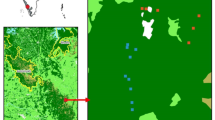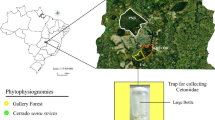Abstract
Identifying the most appropriate bait for a camera trap study is an important step in sampling design, as some baits may perform better than others in attracting different animal species. In this study, we compare the vertebrate communities detected using five different widely used baits (i.e., fruit, sardines, valerian extract, a mix of sweet fruits and peanut butter, and a combination of valerian extract and sardines). We assess their performance and characterize the species best detected by each bait in the diverse Cerrado biome. We identified a total of 46 species of vertebrates: 15 mammals, 4 reptiles, and 27 birds. The baits differed in their estimates of community composition, richness, and abundance. In general, valerian extract detected fewer individuals and species than any of the other baits. Fruits detected the largest number of bird species. Sardines detected the largest number of species overall and were the best bait for felines and reptiles. Baits of an animal origin performed similarly to those of a plant origin. Our study shows that baits should be selected based on the objective of the study.


Similar content being viewed by others
Data availability
All data used in this study is provided in the tables or in the supplementary material.
References
Ahumada JA, Hurtado J, Lizcano D (2013) Monitoring the status and trends of tropical forest terrestrial vertebrate communities from camera trap data: a tool for conservation. PLoS One 8(9):e73707
Andelt WF, Woolley TP (1996) Responses of urban mammals to odor attractants and a bait-dispensing device. Wildl Soc Bull 24:111–118
Anderson MJ, Walsh DC (2013) PERMANOVA, ANOSIM, and the Mantel test in the face of heterogeneous dispersions: what null hypothesis are you testing? Ecol Monogr 83:557–574
Austin C, Tuft K, Ramp D, Cremona T, Webb JK (2017) Bait pref- erence for remote camera trap studies of the endangered northern quoll (Dasyurus hallucatus). Aust Mammal 39(1):72–77
Bessone M, Kühl HS, Hohmann G, Herbinger I, N'Goran KP, Asanzi P, da Costa PB, Dérozier V, Fotsing EDB, Beka BI, Iyomi MD, Iyatshi IB, Kafando P, Kambere MA, Moundzoho DB, Wanzalire MLK, Fruth B (2020) Drawn out of the shadows: surveying secretive forest species with camera trap distance sampling. J Appl Ecol 57:963–974
Campos CM, Velez S, Miguel MF, Papú S, Cona MI (2018) Studying the quantity component of seed dispersal effectiveness from exclosure treatments and camera trapping. Ecol Evol 8(11):5470–5479
Caravaggi A, Banks PB, Burton CA, Finlay C, Haswell PM, Hayward MW, Wood MD (2017) A review of camera trapping for conservation behaviour research. Remote Sens Ecol Conserv 3:109–122
Chupp AD (2005) Habitat selection in four sympatric small mammal species and the effects of potential predators on Peromyscus leucopus. Virginia Commonwealth University Richmond, Richmond
Curveira-Santos G, Marques TA, Björklunda M, Santos-Reis M (2017) Mediterranean mesocarnivores in spatially structured managed landscapes: community organisation in time and space. Agric Ecosyst Environ 237:280–289
Cutler TL, Swann DE (1999) Using remote photography in wildlife ecology: a review. Wildl Soc Bull 27:571–581
Diete RL, Meek PD, Dixon KM, Dickman CR, Leung L-K-P (2016) Best bait for your buck: bait preference for camera trapping north Australian mammals. Aust J Zool 63:376–382
Donatti CI, Guimarães PR, Galetti M, Pizo MA, Marquitti FMD, Dirzo R (2011) Analysis of a hyper-diverse seed dispersal network: modularity and underlying mechanisms. Ecol Lett 14:773–781
du Preez BD, Loveridge AJ, MacDonald DW (2014) To bait or not to bait: a comparison of camera-trapping methods for estimating leopard Panthera pardus density. Biol Conserv 176:153–161
Ferreira-Rodríguez N, Pombal MA (2019) Bait effectiveness in camera trap studies in the Iberian Peninsula. Mammal Res 64:155–164
Ferreras P, Díaz-Ruiz F, Alves PC, Monterroso P (2017) Optimizing camera-trapping protocols for characterizing mesocarnivore communities in South-Western Europe. J Zool 301:23–31
Ferreras P, Díaz-Ruiz F, Monterroso P (2018) Improving mesocarnivore detectability with lures in camera-trapping studies. Wildl Res 45:505–517
Gil-Sánchez JM, Moral M, Bueno J, Rodríguez-Siles J, Lillo S, Pérez J, Martín JM, Valenzuela G, Garrote G, Torralba B, Simón-Mata MA (2011) The use of camera trapping for estimating Iberian lynx (Lynx pardinus) home ranges. Eur J Wildl Res 57:1203–1211
González-Esteban J, Villate I, Irizar I (2004) Assessing camera traps for surveying the European mink, Mustela lutreola (Linnaeus, 1761), distribution. Eur J Wildl Res 50:33–36
Hamel S, Killengreen ST, Henden J-A, Eide NE, Roed-Eriksen L, Ims RA, Yoccoz NG (2013) Towards good practice guidance in using camera-traps in ecology: influence of sampling design on validity of ecological inferences. Methods Ecol Evol 4:105–113
Horn PE, Pereira MJR, Trigo TC, Eizirik E, Tirelli FP (2020) Margay (Leopardus wiedii) in the southernmost Atlantic Forest: density and activity patterns under different levels of anthropogenic disturbance. PLoS One 15(5):e0232013
Jiménez J, Nuñez-Arjona JC, Rueda C, González LM, García-Domínguez F, Muñoz-Igualada J, López-Bao JV (2017) Estimating carnivore community structures. Sci Rep 7:41036
Juarez KM, Marinho-Filho J (2002) Diet, habitat use, and home ranges of sympatric Canids in Central Brazil. J Mammal 83:925–933
Kierulf MCM, dos Santos GR, Canale G, Guidorizzi CE, Cassano C (2004) The use of camera-traps in a survey of the buff-headed capuchin monkey, Cebus xanthosternos. Neotrop Prim 12:56–59
Klar N, Herrmann M, Kramer-Schadt S (2009) Effects and mitigation of road impacts on individual movement behavior of wildcats. J Wildl Manag 73:631–638
Marcon E, Hérault B (2015) Entropart: an R package to measure and partition diversity. J Stat Softw 67(8):1–26
McCallum J (2013) Changing use of camera traps in mammalian field research: habitats, taxa and study types. Mammal Rev 43:196–206
McLean WR, Goldingay RL, Westcott DA (2017) Visual lures increase camera-trap detection of the southern cassowary (Casuarius casuarius johnsonii). Wildl Res 44(3):230–237
Mills D, Fattebert J, Hunter L, Slotow R (2019) Maximising camera trap data: using attractants to improve detection of elusive species in multi-species surveys. PLoS One 14(5):e0216447
Monterroso P, Alves PC, Ferreras P (2011) Evaluation of attractants for non-invasive studies of Iberian carnivore communities. Wildl Res 38:446–454
Oksanen J, Blanchet FG, Friendly M, Kindt R, Legendre P, McGlinn D, Minchin PR, O’Hara RB, Simpson GL, Solymos P, Stevens HWM, Szoecs E, Wagner H (2019) Package ‘vegan.’ R package version 3.4.0
Rocha DG, Ramalho EE, Magnusson WE (2016) Baiting for carnivores might negatively affect capture rates of prey species in camera-trap studies. J Zool 300:205–212
Rovero F, Zimmermann F (2016) Camera trapping for wildlife research. Pelagic Publishing Ltd., Exeter
Sarmento P, Cruz J, Eira C, Fonseca C (2009) Evaluation of camera trapping for estimating red fox abundance. J Wildl Manag 73:1207–1212
Sarmento PB, Cruz J, Eira C, Fonseca C (2011) Modeling the occupancy of sympatric carnivorans in a Mediterranean ecosystem. Eur J Wildl Res 57:119–131
Saunders G, Harris S (2000) Evaluation of attractants and bait preferences of captive red foxes (Vulpes vulpes). Wildl Res 27:237–243
Sebastián-González E, Barbosa JM, Pérez-García JM, Morales-Reyes Z, Botella F, Olea PP, Mateo-Tomás P, Moleón M, Hiraldo F, Arrondo E, Donázar JA, Cortés-Avizanda A, Selva N, Lambertucci SA, Bhattacharjee A, Brewer A, Anadón JD, Abernethy E, Rhodes OE Jr, Turner K, Beasley JC, DeVault TL, Ordiz A, Wikenros C, Zimmermann B, Wabakken P, Wilmers CC, Smith JA, Kendall CJ, Ogada D, Buechley ER, Frehner E, Allen ML, Wittmer HU, Butler JRA, Toit JT, Read J, Wilson D, Jerina K, Krofel M, Kostecke R, Inger R, Samson A, Naves-Alegre L, Sánchez-Zapata JA (2019) Scavenging in the Anthropocene: human impact drives vertebrate scavenger species richness at a global scale. Glob Chang Biol 25:3005–3017
Srbek-Araujo AC, da Cunha CJ, Roper JJ (2017) Post-dispersal seed predation by Atlantic forest squirrels monitoring lowland tapir latrines. Trop Ecol 58(3):673–678
Steen R (2016) Diel activity, frequency and visit duration of pollinators in focal plants: in situ automatic camera monitoring and data processing. Methods Ecol Evol 8:203–213
Thorn M, Scott DM, Green M, Bateman PW, Cameron EZ (2009) Estimating brown hyaena occupancy using baited camera traps. S Afr J Wildl Res 39:1–10
Trolle M, Kéry M (2003) Estimation of ocelot density in the Pantanal using capture–recapture analysis of camera trapping data. J Mammal 84:607–614
Acknowledgments
We are especially grateful to G. de Oliveira, R.C. Rodrigues, A. Orihuela, and A. Camacho for their help with the species identification.
Funding
ESG, ZMR, and LNA were supported by Generalitat Valenciana (SEJI/2018/024, APOSTD/2019/016, ACIF/2019/056).
Author information
Authors and Affiliations
Contributions
ESG, ZMR, CJDA, JASZ, and LNA conceived the idea, all authors performed fieldwork, ESG, ZMR, LGM, and LNA identified species. ESG led the writing. All authors commented and accepted the final version.
Corresponding author
Ethics declarations
Conflict of interest
The authors declare that they have no conflict of interest.
Additional information
Publisher’s note
Springer Nature remains neutral with regard to jurisdictional claims in published maps and institutional affiliations.
Supplementary information
ESM 1
(DOCX 1403 kb)
Rights and permissions
About this article
Cite this article
Sebastián-González, E., Morales-Reyes, Z., Naves-Alegre, L. et al. Which bait should I use? Insights from a camera trap study in a highly diverse cerrado forest. Eur J Wildl Res 66, 99 (2020). https://doi.org/10.1007/s10344-020-01439-1
Received:
Revised:
Accepted:
Published:
DOI: https://doi.org/10.1007/s10344-020-01439-1




